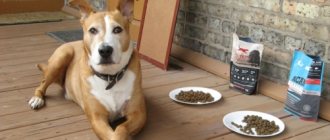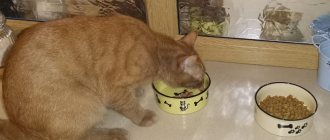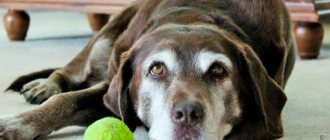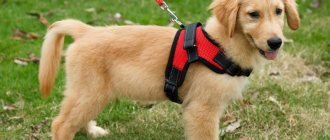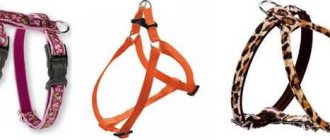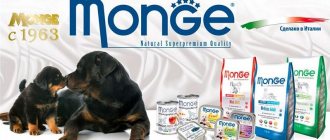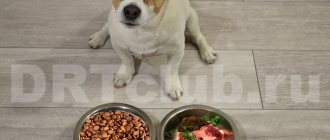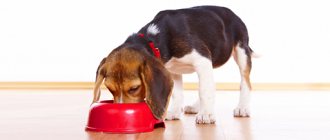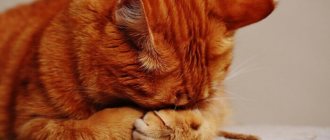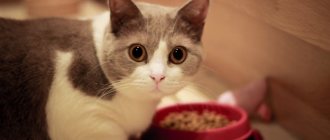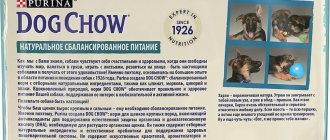Many dog owners, when choosing between dry ready-made food and natural food that they have to prepare with their own hands, prefer the first option. After all, industrial feed has a number of significant advantages:
Photo: dry dog food | Dreamstime.com
- Save time.
Simply pour the required amount of dry granules into the animal’s bowl. But feeding “naturally” requires a significant amount of time spent on purchasing food and preparing meals; - High-quality food
is a balanced product. Whereas when feeding self-prepared foods, it is very difficult to calculate whether the animal receives all the vitamins and microelements in abundance; - Almost all dogs love ready-made dry food.
But it can be difficult to feed the same vegetables to a dog, but without fiber; - Ready-made food does not spoil for a long time.
For comparison: boiled meat up to + 6 degrees is stored for no more than 48 hours, and chilled meat at a temperature not higher than + 4 degrees – 7-10 days; - In a good food, all components benefit the dog.
When feeding “natural” food, it can be difficult to consider which foods can be given to your pet and which cannot (for example, dogs should absolutely not be treated to sausages, mushrooms, citrus fruits, fatty meats, etc.).
The benefits of “drying” are great. But the decision to switch the dog to dry food must be made by the owner himself.
Basic Rules
Since changing a dog’s diet is stressful for the body, it is important to follow the recommendations:
- Do not rush. This can lead to digestive problems - constipation, diarrhea, vomiting. It is preferable to gradually transfer the dog to a different diet over at least 10 days.
- It is advisable to choose premium and super premium food. Cheap types are addictive to the animal (due to the addition of flavorings and taste enhancers).
- Nutrition must be appropriate for the breed and age of the pet. Be sure to take into account the size of the dog and recommendations for the number of pellets per weight of the animal.
- It is extremely important to provide your pet with free access to a bowl of water. Pieces of dry food quickly absorb liquid. If the dog doesn’t have enough of it, digestion will be disrupted. Increased water consumption can lead to "little surprises" on the floor. Therefore, for starters, it is advisable to walk with your pet more often. This way the owner will protect himself from the smell of urine in the house.
- It is better to switch your dog to dry food from the age of three months. Unsoaked granules should be offered to puppies whose baby teeth have already been replaced.
This is interesting: Symptoms of tooth change and a description of the process
It is not advisable to switch dogs over 5 years old to a different diet, as it is difficult, and sometimes impossible, for them to adjust.
By following these recommendations, you will be able to transition your animal to “drying” from natural food as comfortably as possible.
How to choose food
Serious difficulties may arise with the choice of feed. The main criteria are as follows:
- age;
- size;
- characteristics of the breed.
All dry dog food is divided into several categories. They are characterized by their distinctive features.
Economy class is cheaper than others. Such products are not particularly beneficial; constant feeding causes health problems. In the economy group, natural meat is rarely found in the composition, only by-products of dubious quality.
Important! Veterinarians' advice is to avoid economy class, as it can harm your pet. It is better to leave the dog on natural food instead.
Premium class is considered the most popular. The composition also includes various by-products, but there are also meat ingredients (their share is 25-30%). The main component is rice. Most of the product is manufactured in the EU or the USA; the one produced in Russia is inferior in quality.
Super-premium class is characterized by a balanced composition and includes a large amount of meat. In production, a high-quality by-product is used; the packaging indicates which one it is. The composition does not include flavorings or flavor enhancers. Food in this class can be given safely to an adult dog or puppy.
For puppies it is better to choose premium food
Canvas is considered the best option that can be purchased at a pet store. In its production, only natural meat is used; by-products are not included. It is believed that canvas is suitable for a complete diet. You have to pay for high quality; not everyone can afford it for long-term feeding of the dog.
Translation scheme
You need to gradually accustom your puppy to unusual food. Veterinarians and leading dog lovers have developed a single universal scheme that takes into account the physiological characteristics of pets:
- Do not give your dog dry kibble right away. It is advisable to pre-soak them in water for one hour.
- For the first feeding, you need to thoroughly mix the softened industrial dried food with the animal’s usual food in a ratio of 1/2.
- Then, over the course of a week, increase the proportion of granules every two days.
At this time, you need to closely monitor the condition of the puppy’s coat, his mood, well-being, and the presence of allergic reactions. If deterioration is noticed, feeding should be stopped and the baby should be introduced to a different type of food.
This is interesting: Is it necessary to soak dry food for a puppy?
Water and industrial diet for a puppy - important to know!
Having chosen an industrial type of feeding for a puppy, you should make it a rule to ensure that your pet has constant access to a drinking bowl. When feeding dry food, water plays a vital role! When the puppy swallows the granules, they begin to “draw” water into themselves, which provokes acute thirst. The puppy can relieve discomfort and start the digestion process only when he drinks water. The granules will not move into the intestines until they have absorbed enough moisture and become soft.
If you introduce dry food into your pet's diet, make sure that he has several large drinking bowls at his disposal. The water in drinking bowls must be changed at least once a day. During the hot season, deposits quickly form on drinking bowls, so they need to be washed at least 2 times a day.
Pros of feeding dry food
Keeping a dog dry has undeniable advantages.
These include:
- ease of use, no need to prepare, mix, etc.;
- granules do not deteriorate much longer than natural granules;
- industrial food contains the daily norm of nutrients necessary for a dog, a balanced vitamin and mineral complex;
- sometimes “drying” can solve digestive problems (veterinarians specifically prescribe a commercial diet if the puppy is intolerant to certain foods).
There are also negative sides. It is not always possible to correctly translate a dog. Especially if the owner relies on advertised brands of economy-class dry food. The additives they contain are addictive in dogs. At the same time, the transition to higher quality food is perceived negatively by animals. This is because the premium class differs from the cheap “drying” in its naturalness - they do not contain unnecessary flavorings or flavor enhancers.
After eating economy class, the dog may refuse healthier food.
Are there any advantages of dry food over natural food?
The struggle between adherents of two different nutritional principles does not stop. Some consider the benefits of industrial feeds to be limitless, others are against this unnatural type of feeding. However, ready-made food has undeniable advantages:
- Convenience. It is easy to pour the required amount of food, it can be left in a bowl, it can be stored for a long time in open and closed form (you can buy it for future use).
- Is everything ready. You do not need to worry about purchasing raw materials, treating them against parasites, or preparing them.
- Balance. Professional types contain everything necessary for a pet.
- There are specialized foods: hypoallergenic, for older dogs, for individuals with sensitive digestion, diabetics, etc.
- Most pets enjoy eating it.
Feeding standards
It will be possible to finally transfer a healthy puppy from natural food to dry industrial food in a few months. During the first 30 days, you must remember to soak the granules.
It is preferable to divide the food into several times at the rate of 100 g of feed per 10 kg of body. Gradually increase the daily volume by 50 g per day. The share of natural food should not exceed 10% of the total food.
Typical mistakes when changing power supply and related problems
Many owners approach the issue of changing the type of food amateurishly, without studying the necessary literature and without consulting a veterinarian or breeder. As a result, problems arise with feeding the pet, which are often even more difficult to solve than instilling in the puppy a desire to eat food.
Typical training mistakes:
- Incorrect type of feed selected. Each age and breed has its own diet, amount of nutrients and granule size.
- The puppy is immediately given unsoaked dry kibble : unnatural food can injure the gums, and the pet itself can choke.
- The food changes on the same day and the rule of gradual replacement is not followed. This step leads to disruption of the baby’s digestive system, because the body has not yet had time to produce enzymes to break down unfamiliar food components.
- Failure to comply with the feeding standards indicated on the pack leads to serious consequences, including the death of the pet.
- Periodic return to natural food. It is often difficult to accustom a puppy to a new food and returning to the old one can throw all attempts back to square one.
The biggest mistake when teaching a puppy to dry food is the cruel and absurd actions of the owner, who believes that the baby is simply stubborn, and his reluctance to eat new food must be overcome in any way.
Some owners starve their pets in the hope that the puppy will get hungry and start eating. In addition to inhumane actions, such measures can lead to serious complications with the puppy’s health. When it comes to transitioning a puppy to dry food, patience plays a primary role.
Features of transferring puppies
To accustom your puppy to dry food, you need to choose the right brand. It must meet the needs of a growing organism, contain minerals, vitamins, microelements, and nutrients.
The baby’s body changes quickly, its growth increases, which requires a lot of effort, which is replenished with energy received through nutrition. Food for puppies differs from food for mature individuals in the abundance of proteins and fats (30, 20%).
This is interesting: 5 rules for feeding a dog
Such proportions are not suitable for adult dogs (the norm for them is 25, 13%). This category has the widest selection of flavors. The type of food will depend on the activity of the animal.
As dogs age, their mobility decreases and their metabolism slows down. Pets require a more gentle low-calorie diet, which protects them from excess weight and additional stress on internal organs. The vitamin and mineral complex in food for older animals also changes.
Treats for dogs
Dog snacks, which are exactly the same as chips, are a different story.
Types of dog snacks
- Treats for encouragement. Small dry pieces, made in the form of bones, paws or rings, which are given to the dog during training for correctly performed actions. These snacks have a reduced fat content. In order to maintain your pet’s interest in rewarding treats, it is recommended to change them periodically.
- Medicinal treats. Essentially, these are vitamins that contain flavoring additives so that the dog takes them on his own and voluntarily. They contain vitamins and nutrients that have a healing effect. Under no circumstances should you increase the rate of consumption of such treats.
- Oral treats. Just like people, dogs need to maintain their oral hygiene. But brushing an animal’s teeth is not always convenient or safe, so manufacturers of industrial feeds often include in their production a line of snacks that support oral cavity prevention. They massage the gums, remove plaque and improve the functioning of the digestive system.
- Edible toys. These treats are designed for puppies and hyperactive dogs that have a tendency to damage furniture and interior items.
What to do if your dog doesn't want to eat dry food
Some dogs find it difficult to switch to a different diet. In this case, the owners resort to extreme measures - depriving the pet of any food other than dry food for several days. The amount of water is not limited.
But there are particularly persistent specimens that do not respond even to this method. For example, it is not always easy to cope with a small Yorkie, whose character is as independent as it is cheerful.
In particularly difficult cases, it is better to calmly abandon the idea of switching to industrial food and continue to feed the pet what it is accustomed to.
Transferring your pet from food to natural food
There are no problems with changing food, but replacing it with natural food is not an easy task.
The main problem with this is that it is very difficult to create a balanced diet on your own. Therefore, if such a need arises, you should consult a nutritionist. At the same time, it is also necessary to gradually transfer the animal from dry to natural food so that its body has time to adapt and adjust to the new diet. This is the only way you can avoid harming your pet’s health. If you decide to have a pet at home, then remember - this is a big responsibility. In order for the animal’s health to always be in order, it is necessary to create the right diet for it, surround it with attention and care, and also regularly visit the veterinarian with it.
General recommendations
If the dog owner has firmly decided to change the pet’s natural food to dry food, he must take the process responsibly and adhere to a number of recommendations from leading dog breeders.
- You need to think carefully about whether a switch to dry food is necessary, because the changes will greatly affect the animal’s body. It is advisable not to make such a decision without consulting a veterinarian. Only he will be able to assess the dog’s health and recommend the appropriate option.
- It is important to be patient during the transition from natural food to dry food. A quick change can have a bad effect on the physical and psychological condition of the pet.
- It is useful to walk your dog more so that the new food is easier to digest.
- It is better to give preference to more expensive, natural types (holistic, super premium class). They contain ingredients that are beneficial for the development of the animal.
- It is advisable to start using “drying” with high-quality granules, since after economy class the dog may completely refuse good food.
- It is important to choose food that matches the age and breed of the dog.
- Do not forget that during the process of changing food, free access to water is important for the puppy.
- It is necessary to carefully monitor changes in the dog’s mood and well-being during the first time after trying the granules. If the new food causes allergic reactions - redness of the skin, itching, hair loss, it needs to be changed.
- Careful attention to the information on the packaging of industrial feeds will help you correctly calculate the portion depending on the breed, age and weight.
- If a dog categorically refuses to “dry”, despite the owner’s efforts, it is worth leaving it on its usual diet. This applies to animals after five years of age. It is difficult for them to adapt to new conditions of detention.
Switching a dog to dry food from a natural diet is not that difficult. The main thing is to carefully monitor changes in her well-being and mood. To make the process safer, it is advisable to consult a veterinarian.
Why you can’t suddenly switch your puppy to another food
First, let's look at the consequences of an incorrect, abrupt transfer of a pet to another food. And with this everything is pretty standard:
First, the puppy will develop diarrhea. If the baby is no more than three months old, then diarrhea in itself is deadly for him, as it leads to rapid and severe dehydration of the body.
Subsequently, constipation is likely to develop. And in the long term, this pathology is no safer than diarrhea. In particular, chronic autointoxication develops, due to which the kidneys, liver, and the entire excretory system of the body in principle suffer.
Again, in all these cases there is no talk of either normal digestion or normal absorption of nutrients. Accordingly, the puppy’s body does not receive enough nutrients, micro- and macroelements, which has a bad effect on the growth and development of the animal.
Drink plenty of fluids 24/7
Providing your pet with round-the-clock access to fresh, clean water is the first and main rule when using ready-made dry diets.
If wet food and natural meat consist of 60–80% water, then in dry granules it is practically absent. A lack of fluid in the diet negatively affects the functioning of all body systems and can lead to dehydration and the development of chronic diseases. To avoid problems, regularly check the availability of water in your animal. Many dogs refuse cloudy drinks that have previously been contaminated with saliva. And they do the right thing: in such an environment, pathogenic microbes quickly multiply, causing illness and poisoning. Therefore, if you are concerned about your dog’s health, do not be lazy to update the contents of the drinking bowl more often.
Working owners who spend the whole day outside the home are advised to pay attention to automatic waterers - special devices designed to give the dog water without human intervention. They come in two main types:
- with the supply of water from a previously prepared reservoir;
- with connection directly to the water supply system.
Often such gadgets are equipped with filters for water purification, the ability to regulate pressure and other additional functions.
Basic principles for adult pets
The nutrition of puppies and adult dogs is different, so as your pet develops, it is necessary to gradually switch to new feeding regimens that are appropriate for the dog's age. For owners of pets older than 1-2 years, there are certain rules. Basic feeding requirements for adult dogs:
What works for people is often harmful for dogs. You cannot feed human food from the table, treat them with harmful delicacies, or let them try drinks. Dogs benefit from monotony. If you want to pamper your pet, you can sometimes give special treats, but there is no need to come up with a variety of dishes every day. It is better to determine the most suitable products (with natural feeding) or the optimal manufacturer of ready-made food and stick to a monotonous diet throughout life. Do not mix branded food with natural food. Change and adjust the diet only if necessary
Not only the quality of the products is important, but also the correct feeding mode. Receiving food at the same usual time helps the proper production of digestive juices, promotes comfortable digestion, and has a positive effect on metabolism
The serving size of the food should be appropriate for the size of the dog. You should not overfeed your pet, even if he plaintively begs for more, having previously eaten a full portion. It is also harmful to keep your dog hungry. Be sure to take into account the physiological state of the pet, its age, and lifestyle. When feeding natural products, it is necessary to periodically introduce mineral and vitamin supplements into the diet. It is important to combine and prepare products correctly. You need to monitor the temperature of the feed. Since hot or cold foods can damage your pet's digestive tract, you need to bring the temperature of the food closer to 30 - 35 degrees, which is slightly lower than the animals' normal body temperature.
A caring owner should also pay attention to how the pet eats: what kind of appetite it is, whether it asks for more or, on the contrary, leaves some of the food, is it difficult to swallow. It is useful to evaluate how a dog approaches a bowl of food and what it does after eating in order to assess the pet’s well-being as informatively as possible.
You need to pay attention to any changes in order to understand how the dog feels and whether it needs help and, accordingly, dietary adjustments.
For your information! It is necessary to monitor the cleanliness of water and food bowls. Wash dishes thoroughly regularly without chemical cleaning agents. The food bowl must be put away in the cupboard on time.
There must be fresh water freely available and in sufficient quantity so that the pet can drink at any time. The water needs to be changed daily. It is also useful to monitor how your dog drinks - whether he is thirsty or, conversely, whether the pet drinks enough water. If necessary, this data can tell a lot.
